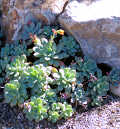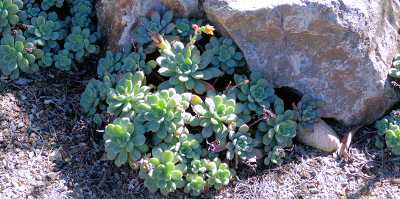Microclimates and Plant Placement
FOOD PLANTS
Culinary Herbs
Fruit, Berries, Nuts
Peppers, Chilies
Strawberries
Tomatoes
Vegetable Calendar Zone 9
ORNAMENTALS
Grasses
Ground Cover
Perennials
Shrubs
Succulents
Trees and Palms
Vines
SPECIALTY GARDENS
Butterfly Garden
Erosion Control
Fragrance Garden
Hedges, Barriers, Screens
Hummingbird Garden
Long Blooming
Winter-Blooming
GARDENING TIPS
Dealing with Critters
Digging Holes for Plants
Fruit: Selection, Cultivation
Garden Bed: Sterilizing
Landscaping
Microclimates
Parasitic Plants
Plant Placement
Selecting Plants
Soil Prep for Vegetables
USDA Hardiness Zones
Planting, Watering, Shrubs, Trees
NURSERIES / SUPPLIES
Online
Phoenix
Tucson
MEETINGS
Phoenix Meetings
Tucson Meetings

Each wild plant community has a set of factors which cause that group of plants to be found together. These include sunlight and shade, slope of ground, wind exposure, moisture, soil quality and temperature. Taken together, these factors are called a microclimate.
Often when we refer to a microclimate we are talking about a small area, possibly as small as a few square feet (one square meter). In other words, a microclimate is simply the local climate on a small scale. This small area has elements that cause it to be slightly different than the overall climate of a city or county. In the mountains of the desert southwest, gardeners experience a tremendous diversity of natural microclimates.
It is possible to create a microclimate to improve the growth and success of one or more plants. However, whether you simply want to make the best use of the natural microclimates of your property or create a special situation for a selected plant, you should know how to recognize and modify the elements that create one.
Sunlight and Shade
Temperature is affected by the amount of sunlight an area receives.
Areas that get little or no sun tend to be cooler than those that receive a great deal of sun.
The physical elements that affect the amount of sun an area receives include houses, walls, fences,
mounded earth works, slopes and even where you park your car. Reflective surfaces such as windows
and pools can add extra light and heat to a plant. Biological elements that provide shade include
trees, shrubs, ground cover, grass and mulch.
The amount of shade an area receives depends upon the season. In winter the angle of the sun is lower, to about 34 degrees in Tucson and 33 degrees in Phoenix. In summer the angle of the sun is much higher, 81 degrees for Tucson, 80 degrees for Phoenix. A second factor is that the sun rises and sets on the north side of Tucson and Phoenix nearly six months of the year. From the start of spring to the start of fall, sunrise and sunset provide sun on the north side of every house. Seasonal shade is also provided by deciduous trees that provide shade in the summer and allow winter sun to warm the ground and nearby structures.
Eastern Exposures
Receive sun in the morning and shade or reduced sunlight in the afternoon all year.
These areas are cooler and lose less moisture from the soil. Plants that like part shade
and moister soil do well there. However, a light-colored wall or reflective surface turns
this area into a stressful hot zone and negates the eastern exposure effect.
Western Exposures
Provide shade in the morning with sun in the afternoon. In summer
these areas are hotter and their soil is drier. In the spring and fall, however, hot afternoon
temperatures and cold nighttime temperatures can damage sensitive plants. The temperature extremes
of western exposures are best for hardy plants that like dry soil, hot temperatures and part shade.
Deciduous trees on a west side can be used to shade a house in summer yet allow sunlight
to warm it in winter.
Northern Exposures
Have full shade most of the day with the coolest temperatures
and most moisture year round. Plants that prefer cooler temperatures, higher humidity and
less light do well there.
Southern Exposures
Are hotter, brighter and drier in the summer, especially if next to
a light-colored structure. Southern and south-western exposures provide the most warmth in the
winter. Plants that prefer warm temperatures do better there.
Slopes
The governing principle of slope temperature is that warm air rises and cool
air sinks. The tops of slopes are warmer, the bottoms cooler.
Slope moisture and soil structure varies with location and steepness. On the top of a slope
the soil is usually rockier and courser. This type of soil drains well and holds less moisture.
At the bottom of a slope, because of rainwater runoff and erosion, the soil is moister, finer
and higher in nutrients. Further, the steeper the slope in the middle, the drier the soil.
Slopes that face south or west are warmer. Plants on these slopes often bloom and leaf out first in the spring. Plants that prefer elevations that are lower and warmer than your location will do better on south- and west-facing slopes. Slopes that face north are colder and moister. This is the location for plants that prefer higher elevations and cooler temperatures than your location.
Installing retaining walls or rock dikes crosswise to a slope, creating terraces, helps reduce runoff. Wildflowers are known to spontaneously appear on these terraces.
Air Circulation
Sinking cold air can form frost pockets in basin areas in the wintertime.
Look around your yard on an early morning when the temperature is below freezing.
Where there is frost on the vegetation there is a low spot in your yard.
If frost is a problem, provide air drainage just as you would water drainage.
Wind
Wind affects a microclimate by drying and heating or cooling plants depending on the
relative air temperature.
Be aware of trees, hedges, walls, paving and dirt roads that channel wind.
Groves of trees or shrubs create "outdoor rooms" with reduced wind velocity.
Stone walls and tall evergreen hedges can protect from wind year round.
In areas with no prevailing wind direction, a circular or rectangular hedge can be grown to
protect sensitive plants from wind.
Rainwater Harvesting
A major purpose of rainwater harvesting is to spread rainfall water out over a larger
area and slow it down so that it sinks into the soil, becomes available to plants and does not
cause erosion.
Roofs, patios, sidewalks and paving create areas of high water runoff that can be collected in
large containers for later reuse.
In addition to collected rainwater, channels can be dug on slopes to manage rainwater flow and
divert it near trees and shrubs needing water.
Rock beds in channel bottoms, rock dikes and rock edging can be used to slow and direct water
flow and give it more time to sink into the soil.
Trees and shrubs that do not tolerate flooding can be placed above low areas where rainfall is
allowed to collect.
Plants that tolerate periodic flooding such as Desert Willow and Mesquite can have rainwater
pool around their roots and be slowly absorbed into the ground.

A backhoe can be used to dig a hole 8 x 8 x 6' (2.5 x 2.5 x 2m) deep at the bottom of a slope. The hole can be filled with cactus or brush and then topped with the entire quantity of original dirt to form a mound. This hole then becomes an underground cistern to trap rainwater which nearby trees will exploit. As vegetation in the hole rots, the mound above it will subside to become flat. As long as the rotted vegetation in the hole is less dense than the surrounding dirt it will continue to store water.
Soil Moisture
Plants compete for water, some with shallow roots and some with deep roots.
A few plants will dry out the soil around them, leaving no moisture for neighbors.
Know which plants are moisture hogs and what distance is needed between the various plants in
your garden.
Soil
Modifying pH-neutral to alkaline soil for acid-loving plants requires a lot of material,
work and money.
If you modify the soil for acid-loving roses, you will not be able to grow native desert
plants in that location later without replacing the soil.
To adequately control soil acidity and moisture for plants such as blueberries, very large
containers with sides protected from the sun and holes in the bottom are an effective solution.
Heat Control
Plants do best in a certain temperature range. Cold temperatures slow or stop
growth and inhibit seed germination and pollen development. Warm temperatures speed growth but
also increase plant respiration, loss of moisture, food consumption and reduce sugar content
of fruit. The best temperature range, cooler or warmer, depends upon each species of plant.
Fruit trees such as apple and plum are cold climate crops that need winter chill hours.
Other trees prefer to stay relatively warm all year.
Color
Color influences microclimates because dark-colors absorb light and retain heat and white
reflects heat and light. Dark mulch will warm the soil earlier in the spring,
and very light mulch and surfaces are great for those plants that love reflected
heat in the summer.
Rocks
The effectiveness of rocks in absorbing heat in the day and releasing it at night depends
upon their size.
Small dark rocks will heat to their cores quickly and start radiating heat back in all
directions during the day.
Very large dark rocks can absorb heat during the day and not radiate it until the evening
because their core temperatures do not reach their surface temperature until late in the day,
if at all.
Large boulders can keep an area warmer and extend a growing season by several weeks in the
spring and fall.
Walls
A light-colored wall reflects sunlight and heat spring through fall and creates a hot zone
that can be stressful for nearby plants. A dark, rough-surfaced wall reflects less heat and
light but stores it for later release when the sun is no longer shining upon it.
This spreads the duration of the heat over a longer time period and can be beneficial in
cold weather.
Paving
The more paved area you have -- especially with light-colored paving -- the more heat will
be reflected onto nearby plants.
Reducing paving and adding more ground cover or other plants will help reduce temperatures.
Assessing Your Microclimate
Map out your property and identify those elements that affect the surrounding microclimate.
Be aware that some microclimate elements may cancel each other out.
For example, if one area has shade from east and west, but a south-facing wall on the north
side is white, any plants in that location will be hit with high temperatures in the middle of
the day.
Also, slopes may exaggerate or cancel temperature and moisture situations.
Plant Categories
There is a difference between desert (native) plants that need full sun and plants from
other climate zones.
Outside the monsoon season, the desert southwest seldom has clouds and the sun is intense.
Full sun for non-desert plants means part shade in the desert, especially afternoon shade.
Most successful gardens have part shade from tall trees.
Some native desert plants, however, do need full sun to protect against fungal infections
during the rainy season.
Plants with aggressive roots do better in very dry situations but must be kept away from septic fields, sewer lines and water lines.
Plants that need good drainage, often desert-adapted plants, will not do well in a low area where water collects or drains poorly. Place these on slopes, ridges or areas that drain well.
See also Landscaping Desert Gardens.
Latest update: July, 2020
© 2008-2025 by GardenOracle.com

